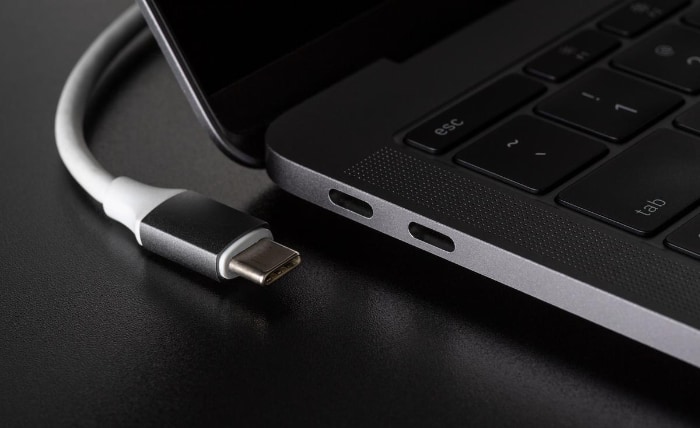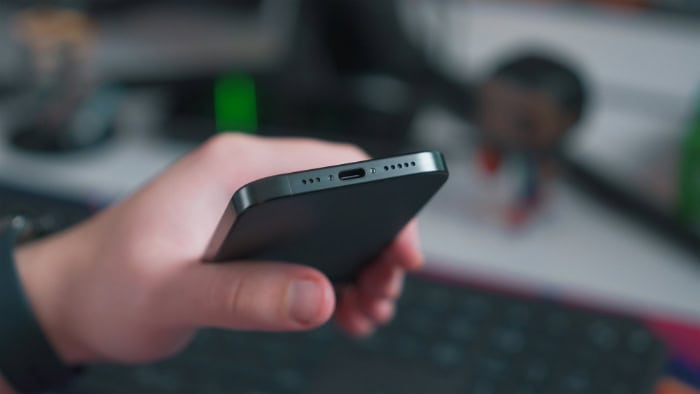Can I Charge My Phone with My USB-C Laptop Charger?

Plugging your phone into a high-wattage laptop charger feels risky, raising fears of a fried battery. Yet, the promise of carrying a single charger for all your devices is too convenient to ignore.
The truth is, modern USB-C chargers are designed with this exact scenario in mind. Thanks to the USB Power Delivery (PD) protocol, your phone and charger can negotiate a safe power level, preventing damage.
This system allows a powerful laptop adapter to safely provide a much lower wattage suitable for your phone. However, compatibility isn't guaranteed.
Success depends on both devices supporting the PD standard, the quality of your cable, and the specific power profiles the charger offers. Getting it wrong might not destroy your device, but it could mean slow speeds or no charge at all.
How USB Power Delivery Works
The USB Power Delivery standard creates a communication channel between a charger and a device, enabling them to safely agree on a charging speed. This protocol is what prevents a powerful laptop charger from overloading and damaging a smaller device, such as a smartphone.
It establishes a negotiation where the device in need of power ultimately dictates how much electricity it receives.
Power Negotiation
The connection process begins with a digital handshake between the charger and the phone. During this exchange, the charger announces all the power profiles it can offer.
The phone then evaluates these options and requests a profile that matches its own charging capabilities. A high-wattage laptop charger will not force an excessive amount of power into a handset because the phone will only select a supported, lower-power option from the charger's advertised list.
The phone remains in control of the transaction.
Voltage Profiles and Safety
Chargers compliant with the standard provide multiple voltage profiles, such as 5 volts, 9 volts, and 20 volts. When first connected, the charger defaults to the safest and most universal level, which is 5 volts.
This baseline ensures that any USB-C device can draw a minimal amount of power without risk. If the connected phone supports higher-wattage fast charging and confirms a compatible profile is available, it will then instruct the charger to switch to a higher voltage mode like 9 volts to accelerate charging speed.
Reading the Charger Label
You can verify a charger's capabilities by examining the fine print on its casing. A charger that supports USB Power Delivery will often display the “PD” logo or list multiple output specifications.
Look for a series of voltage and amperage pairs, for example, “5V/3A, 9V/3A, 20V/3.25A.” The presence of a 5V option is a strong indicator of standards compliance and phone compatibility. A charger that only lists a single high voltage is not suitable for charging a phone.
Ensuring Device Compatibility

Successfully using a single charger for multiple devices requires more than just a matching port. True compatibility depends on a trio of factors: the charger's capabilities, the phone's power requirements, and the quality of the cable connecting them.
Verifying that each component meets the necessary standards is essential for safe and efficient charging.
Verify PD Support on Devices
The first step is to confirm that both your phone and laptop charger support USB Power Delivery. For the charger, look for the official PD logo or examine the fine print on the power brick.
A compliant charger will list multiple output voltages, such as 5V, 9V, and 20V. This range indicates its ability to serve different types of devices. For your phone, check its technical specifications on the manufacturer's website or in its documentation to confirm it accepts charging via the PD protocol.
Use Certified Cables
The USB-C cable is an active component in the power negotiation process, not just a simple wire. Using a low-quality, damaged, or uncertified cable can prevent the PD handshake from completing correctly.
This can lead to slow charging speeds or cause the connection to fail entirely. To ensure a reliable connection, use cables from reputable manufacturers or those that are officially certified.
Always avoid cables that are frayed or show signs of physical damage, as they can impair negotiation and pose a safety risk.
Universal Standards and Device Limits
Regulatory efforts, such as the European Union's common charger mandate, have greatly improved cross-brand interoperability by standardizing the use of USB-C. This move encourages a future where one charger can power many devices.
However, these regulations do not override the technical limitations of individual products. Even with a universal port, the actual charging performance is still determined by the protocols supported by the specific phone and charger.
The device itself ultimately governs the final charging rate.
Charging Performance
While a USB-C laptop charger will often power your phone, its charging speed may not match that of the adapter included with your device. Performance is dictated by a combination of charging protocols, the phone's maximum power limit, and the quality of the connecting cable.
These factors determine whether your phone charges at its fastest possible rate or defaults to a slower, more basic speed.
Proprietary Protocols and Charging Rates
You may notice that charging speed differs from what you get with the stock adapter. Many phone manufacturers use their own proprietary fast-charging technologies to achieve the advertised peak rates.
A universal USB-C PD laptop charger, while compatible, may not support these specific protocols. In such cases, the phone and charger will fall back to a standard PD profile they both support, which typically results in a slower, but perfectly functional, charging speed.
Basic charging will almost always work, but peak performance often requires a matched set of hardware.
Wattage and Actual Charging Speed
Having a charger with extra wattage does not guarantee faster charging. The phone itself ultimately controls the power draw, limiting it to its own maximum capacity.
A phone designed to accept a maximum of 25 watts will not charge any faster when connected to a 100-watt laptop adapter. It will simply negotiate with the charger and select a supported power profile, such as one providing 25 watts, and ignore the charger's higher-wattage capabilities.
The additional power potential of the charger remains unused.
The Role of Cable Quality
The quality and rating of your USB-C cable directly affect charging current and stability. A well-made, certified cable ensures that the power negotiation between the phone and charger proceeds correctly, allowing fast-charging modes to engage consistently.
A substandard or damaged cable, however, can act as a bottleneck. It might fail to communicate its ability to handle higher currents, forcing the system to default to a much slower and safer charging rate to prevent overheating or other issues.
Risks and Safety Practices

While the USB-C standard is designed for safety, potential risks emerge when using non-compliant or mismatched equipment. Following best practices is crucial for protecting your devices from damage and ensuring a reliable charging experience.
The quality of your hardware and your charging habits play a significant role in maintaining both safety and battery health.
Dangers of Non-Compliant Chargers
Using chargers that are poorly made or do not support the USB Power Delivery protocol can lead to several problems. These non-PD chargers lack the necessary communication logic to negotiate a safe voltage with your phone.
This can result in incompatibility where the phone refuses to charge, significant throttling that slows charging to a crawl, or excessive heat buildup. To avoid these issues, always prioritize hardware from reputable manufacturers that is explicitly advertised as standards-compliant.
Avoid Proprietary Adapters
You should never use older, proprietary laptop chargers to power your USB-C phone, even with an adapter. Many laptops use power bricks with barrel connectors or other non-USB-C plugs that are not designed to work with the PD standard.
Attempting to connect one of these to a phone via an adapter is risky because the charger cannot perform the required safety negotiation. At best, it will fail to charge your device; at worst, it could deliver an incorrect voltage and cause permanent damage.
Manage Heat and Battery Health
To preserve your phone's long-term battery health, it is wise to manage heat exposure during charging. Fast charging with a high-wattage source naturally generates more heat than slower charging.
While convenient for a quick top-up, leaving your phone connected to a powerful laptop charger overnight subjects the battery to prolonged periods of unnecessary heat. This can accelerate battery degradation over time.
For overnight charging when speed is not a priority, using a lower-wattage adapter can help minimize heat and extend the life of your battery.
Practical Use Cases and Charger Selection
Knowing when to use a universal laptop charger versus your phone's original adapter allows you to balance convenience with performance. The right choice depends on your situation, whether you are trying to minimize clutter while traveling or seeking the fastest possible charge at home.
A Single Charger for Convenience
For travel and minimalist desk setups, a single, high-quality USB-C PD charger is an excellent solution for reducing clutter. When your laptop, phone, and other gadgets all support the USB Power Delivery standard, one power brick can service all of them.
This eliminates the need to carry multiple adapters and cables. As long as you have confirmed compatibility and are using a certified cable, you can confidently power both your laptop and phone from the same source, making it an ideal choice for streamlining your gear.
Optimal Charging with the Original Adapter
For the most predictable and efficient charging, your phone's recommended wall adapter is often the best option. It is specifically designed to work with your device's battery and charging system, guaranteeing access to any proprietary fast-charging modes for the quickest speeds.
The stock adapter is also a great choice for gentle overnight top-ups, as it provides exactly the power your phone needs without the potential for excess heat that can come from a more powerful laptop charger.
Troubleshooting Charging Issues
If you find that charging is unexpectedly slow or fails to start, there are a few things to check before assuming your hardware is faulty. First, verify the cable, as it is a frequent point of failure.
Try a different, certified USB-C cable to see if the problem resolves. Next, re-examine the text on the charger itself to ensure it lists a 5V output profile, which is necessary for safe, basic communication.
Finally, confirm that both the charger and your phone officially support the USB Power Delivery standard. Following these steps can often resolve the issue without needing to replace equipment.
Conclusion
A USB-C laptop charger can serve as a safe and effective power source for your phone, so long as both devices adhere to the USB Power Delivery standard. The success of this convenient, one-charger setup hinges on proper communication between the charger and the phone, which is enabled by compliant hardware.
Before plugging in, confirm that the charger's label indicates PD support and lists multiple voltage profiles, including the essential 5V output. Using a certified, high-quality cable is just as important, as it facilitates the negotiation that protects your device.
While this universal approach is excellent for travel and minimizing clutter, remember that for achieving the absolute fastest charging speeds, the original adapter supplied with your phone remains the most reliable choice. Ultimately, prioritizing reputable gear and matching protocols ensures both safety and performance.


